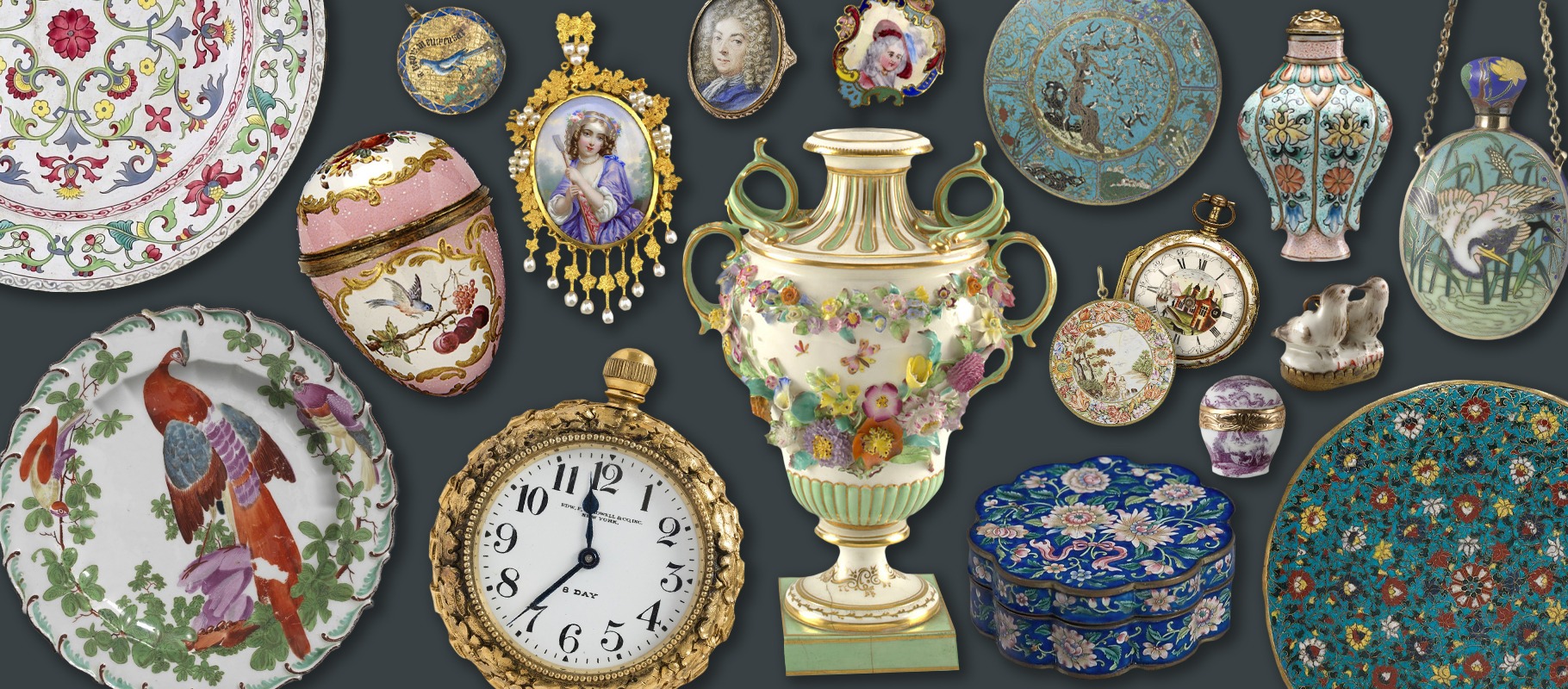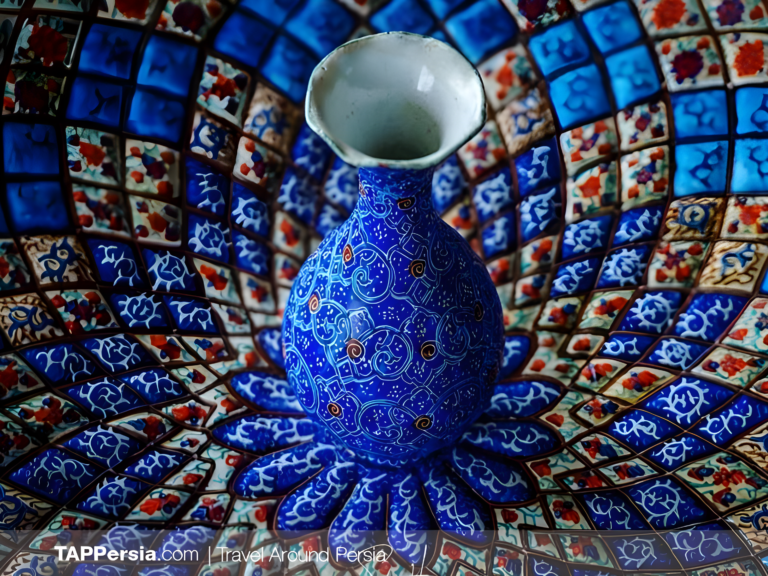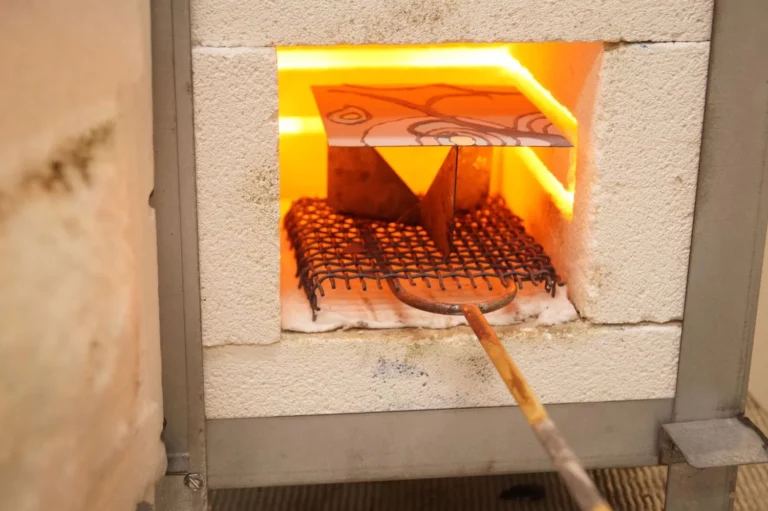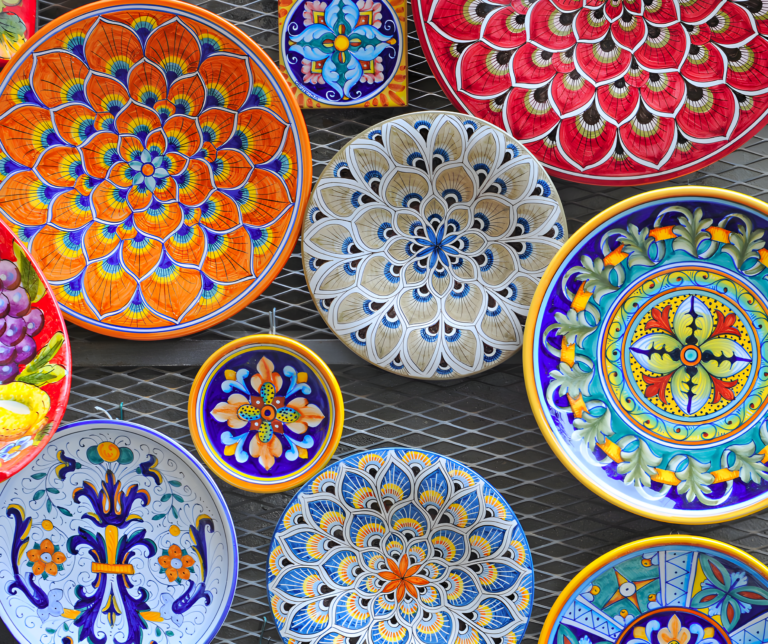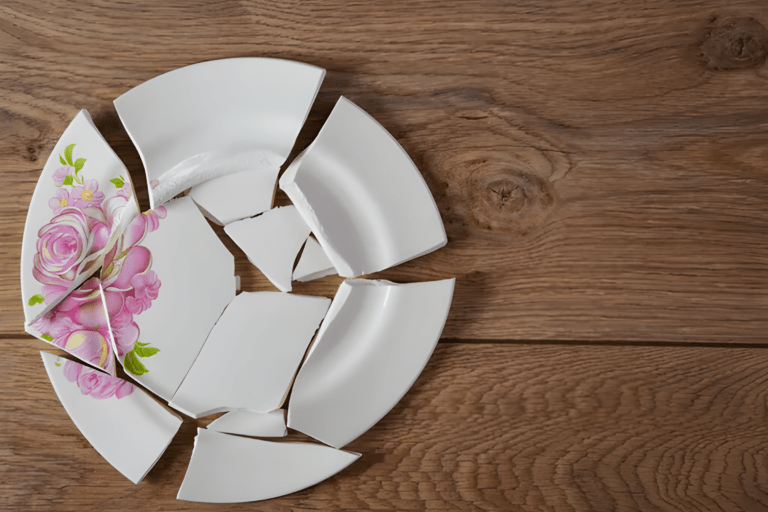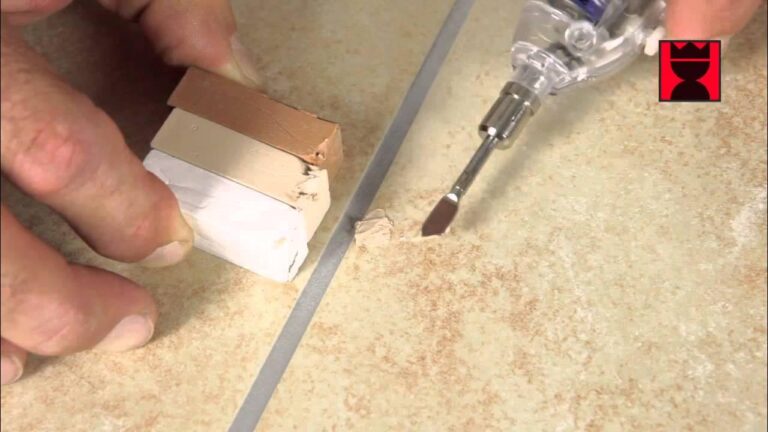Protecting Antique Enamel: Preservation, Care, and Restoration
Enamel has adorned decorative ceramics, metal objects, and miniatures for centuries, adding vibrant color and texture to everything from porcelain vases to snuff boxes. Whether it appears as a glossy surface on a clock face or in intricate patterns on a jewelry box, enamel is a fusion of artistry and chemistry. However, time takes its toll, and this once-radiant material may crack, fade, or chip away. Understanding the enamelling process and proper preservation techniques is essential to maintaining these delicate antiques.
The Science Behind Enamel
At its core, enamel is a type of glass—a powdered frit that is melted and fused onto a metal or ceramic base. This process, known as vitreous enamelling, creates a smooth, glossy finish that is both decorative and protective. The mixture typically includes sand, soda, red lead, and potash, with added oxides to produce different colors and opacities.

Enamel’s beauty comes from its depth and luster, but its glass-like nature makes it susceptible to chipping and wear over time.
The enamelling technique has evolved over centuries, with artisans developing various styles to achieve unique textures and visual effects. Some forms, like cloisonné, involve thin metal wires forming compartments that hold different enamel colors. Others, such as basse-taille, feature engraved designs beneath translucent layers of enamel.
Traditional Enamelling Techniques
Enamelling is an ancient craft, with different cultures developing distinct decorative methods. Some of the most notable include:
- Cloisonné — Metal wires create enclosed compartments filled with enamel, a technique famously used in Chinese and Japanese art.
- Champlevé — Enamel fills carved recesses in a metal or ceramic surface, producing a textured effect.
- Painted Enamel — Enamel is applied as a paint to create miniature artworks, especially in European traditions like Limoges enamel.
- Plique-à-jour — A delicate technique similar to stained glass, with enamel applied without a backing to let light pass through.
Each method requires precise craftsmanship, with layers of enamel applied and fired at temperatures ranging from 700 to 900 °C to achieve the desired color and depth.
The Aging Process: What Happens to Enamel Over Time?
Enamel may appear smooth and durable, but beneath its glossy surface lies a material that is surprisingly fragile. As with any glass-based substance, enamel undergoes natural changes over time, influenced by environmental conditions, handling, and even the quality of its original craftsmanship. While well-preserved pieces can retain their brilliance for centuries, others may exhibit signs of deterioration, revealing the complex aging process of this delicate decorative medium.
One of the most common issues affecting enamel is crazing, a fine network of cracks that forms on the surface due to stress and fluctuations in temperature or humidity. Unlike deep fractures, crazing does not always compromise the structural integrity of an object, but it does weaken the enamel, making it more susceptible to chipping and further deterioration. Once crazing appears, it often spreads gradually, especially if the enamel undergoes continued environmental stress.

Chipping and flaking occur when the enamel layer becomes detached from its underlying metal or ceramic base. This can result from impact, but also from unseen chemical changes within the material itself. Enamel expands and contracts at a different rate than its supporting structure, and if these movements become too extreme—due to rapid temperature shifts or prolonged exposure to moisture—the bond between the layers weakens. This is particularly evident in antique cloisonné and basse-taille enamelwork, where small fragments may begin to loosen and detach.
Another sign of aging is color fading or dulling, which can happen when enamel is exposed to light, air pollutants, or chemical reactions within its composition. Some antique enamel pieces, especially those containing unstable pigments or oxides, may lose their vibrancy over time, leading to a muted or clouded appearance. Additionally, certain types of enamels, such as translucent basse-taille designs, can develop a hazy or yellowed surface due to microscopic changes in the glass structure.
Unlike modern synthetic coatings, antique enamel does not have built-in UV protection, making prolonged exposure to sunlight a risk factor for discoloration and surface degradation.
Structural weakening of enamel is often linked to the degradation of the base material. For example, metal objects with enamel decoration can develop corrosion or oxidation, especially if stored in humid conditions. When the underlying metal expands or becomes unstable, it exerts pressure on the enamel layer, causing stress fractures or even complete separation. Porcelain or ceramic enamel pieces, on the other hand, may suffer from glaze spalling, where the enamel begins to lift and peel away due to changes in the clay body beneath it.
While some signs of aging are inevitable, the rate at which enamel deteriorates depends on how it has been handled and stored over the years. Objects that have been kept in stable conditions, protected from excessive moisture, pollutants, and abrupt temperature shifts, often maintain their original beauty far longer than those exposed to fluctuating environments. Proper conservation measures can slow down this process, but once enamel begins to degrade, professional intervention is often necessary to prevent further loss.
Once enamel starts to crack or detach, the damage typically worsens over time. Even minor surface imperfections can indicate deeper structural issues developing beneath the surface.
Ultimately, antique enamelware is a delicate fusion of art and chemistry. While its aging process can be unpredictable, understanding the factors that contribute to its deterioration helps collectors and enthusiasts take the necessary steps to preserve its beauty for future generations.
How to Care for Antique Enamelware
Proper handling and storage are key to preserving enaCaring for antique enamelware requires a thoughtful approach, as even minor mistakes in handling, cleaning, or storage can accelerate its deterioration. While enamel may seem resilient due to its glossy, glass-like surface, it is highly sensitive to environmental changes, physical stress, and chemical exposure. Understanding the specific needs of antique enamel objects ensures their preservation for future generations.

Handling with Care
The first and most crucial step in enamelware preservation is mindful handling. Enamel surfaces are prone to chipping and cracking upon impact, so every movement should be deliberate and controlled. When lifting an enamel object, always support its base rather than gripping delicate edges or protruding decorative elements. Wearing clean, dry gloves can also minimize the transfer of oils and moisture from the skin, which may contribute to surface degradation over time.
Even hairline cracks in enamel can expand over time due to repeated handling, making it essential to minimize unnecessary movement and contact.
Cleaning Without Damage
Cleaning antique enamelware requires a gentle, non-abrasive approach. Dust and dirt can settle into fine cracks and pores, gradually dulling the surface or even causing further stress. To remove surface dust, use a soft, dry microfiber cloth or a natural-bristle brush. If more thorough cleaning is needed, a slightly damp cloth with distilled water is the safest option.
For objects with stubborn dirt, a mild, pH-neutral soap can be used sparingly. However, it is critical to avoid harsh chemicals, acidic cleaners, or abrasive sponges, as these can strip away the enamel’s protective surface or cause micro-scratches that weaken the material. Enamel should never be soaked in water, as prolonged exposure to moisture can seep into cracks and disrupt the bond between the enamel and its base.
Many antique enamel paints contain sensitive oxides that react to strong chemicals, leading to discoloration or permanent damage.
Creating a Stable Storage Environment
The longevity of enamelware heavily depends on the conditions in which it is stored. Sudden fluctuations in temperature and humidity can cause the material to expand and contract at different rates, increasing the risk of cracks and separation from its base. Ideally, antique enamel should be kept in a stable environment with moderate humidity (around 40−50%) and a consistent temperature, avoiding extremes of heat or cold.
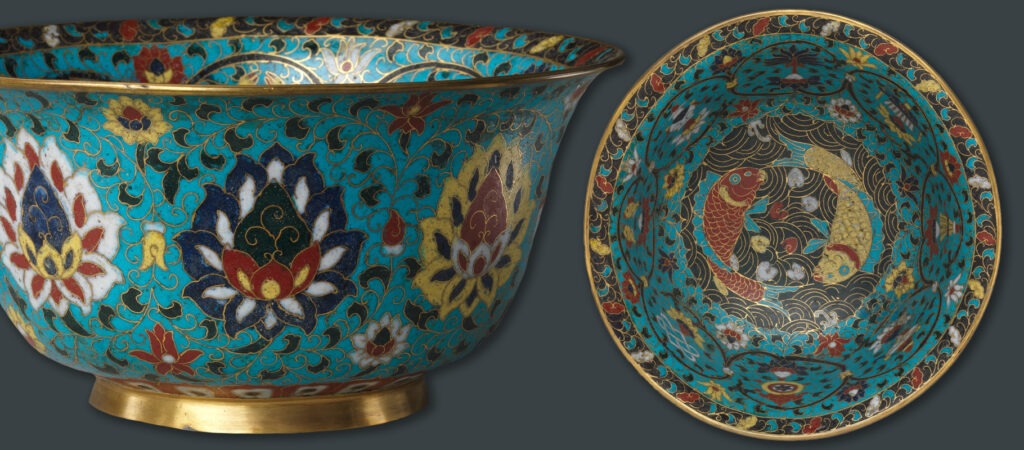
Displaying enamelware behind glass in a cabinet provides an additional layer of protection from dust, pollutants, and accidental knocks. When storing multiple enamel pieces, ensure they are not stacked or placed in direct contact with one another. A soft, non-reactive padding material—such as acid-free tissue paper or padded fabric—can be used to create gentle separation and prevent chips or scratches.
Preventing Long-Term Wear
Direct exposure to sunlight can cause certain enamel pigments to fade or discolor over time. UV rays can also weaken the structural integrity of older enamel coatings, making them more prone to hairline fractures. Positioning enamelware away from windows or strong artificial light sources can help preserve its original vibrancy.
Additionally, antique enamel should be kept away from corrosive materials, including acidic vapors from household cleaners, perfumes, or even certain types of aged wood that emit natural acids. These substances can gradually erode the enamel surface or react with underlying metals, leading to tarnishing or instability.
Addressing Minor Damage
If an enamel object develops small cracks, chips, or signs of instability, it is crucial to take action before the damage worsens. In cases of minor surface imperfections, professional conservationists can stabilize the enamel using specialized techniques that prevent further flaking. Collecting any detached fragments and storing them safely can aid in future restoration.
Under no circumstances should household adhesives or commercial fillers be used to repair enamel, as they can cause chemical reactions that permanently alter the material. Instead, seeking expert restoration ensures that the integrity of the piece remains intact while preserving its historical and artistic value.
Once enamel begins to flake, the deterioration process is difficult to stop without professional intervention. Preventative care is always the best approach.
By adopting careful handling, gentle cleaning methods, and protective storage solutions, antique enamelware can be enjoyed and preserved for generations. While enamel may be fragile, its beauty and craftsmanship deserve the patience and diligence required to maintain its brilliance over time.
When to Seek Professional Restoration
Antique enamelware is a delicate and often irreplaceable form of craftsmanship, making professional restoration essential when signs of deterioration appear. While some surface wear can be stabilized through careful handling and proper storage, there are situations where intervention by a skilled conservator is the only way to prevent irreversible damage. Recognizing the right time to seek restoration can mean the difference between preserving a piece’s historical and artistic integrity or allowing it to deteriorate beyond repair.
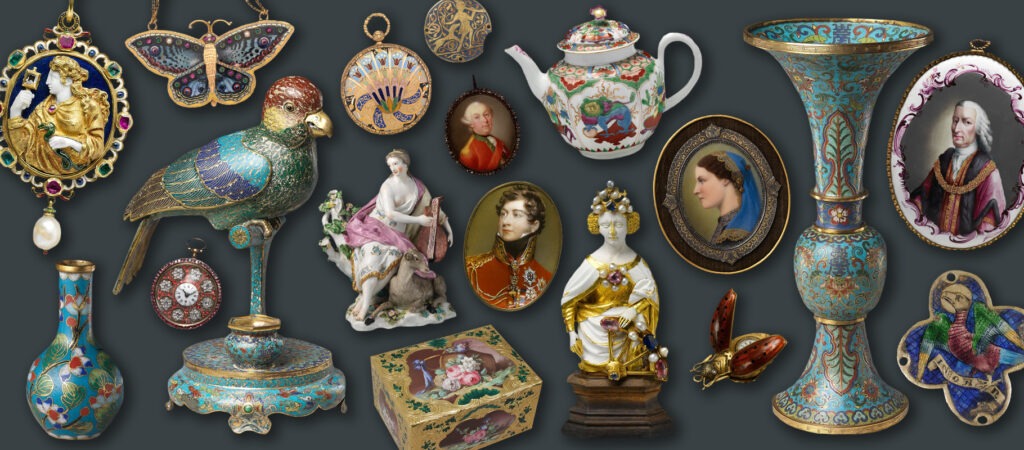
Visible Structural Damage
One of the clearest indicators that professional help is needed is significant chipping, cracking, or flaking of the enamel surface. Unlike minor surface crazing, which can sometimes remain stable for years, larger fractures create weak points that continue to spread. Once the enamel begins to detach from its metal or ceramic base, the structural bond is compromised, making the object vulnerable to further damage with even the slightest handling.
Even a small chip can expose underlying layers to moisture and environmental stress, accelerating the deterioration process.
Color Alteration or Staining
Discoloration in antique enamelware is not always due to natural aging. In some cases, oxidation, chemical reactions, or exposure to pollutants can lead to visible staining or color shifts. Certain enamel pigments—especially those containing metallic oxides—may react with environmental factors, resulting in dulling, yellowing, or uneven dark patches. A professional restorer can assess whether the change is superficial or indicative of deeper structural instability and apply appropriate conservation treatments to prevent further alteration.
Loss of Gloss and Surface Wear
Over time, enamel surfaces may lose their original shine due to abrasion, micro-scratches, or exposure to acidic substances. While this might seem like a minor cosmetic issue, a dull or pitted surface can indicate that the enamel has been gradually worn down, reducing its durability. Unlike modern coatings, antique enamel does not have protective sealants, meaning its surface can become more porous and prone to further deterioration. Restoration experts use specialized polishing and stabilization techniques to restore lost brilliance without damaging the integrity of the piece.
Underlying Material Instability
The stability of enamelware depends not only on the enamel itself but also on the condition of its underlying metal or ceramic base. If corrosion, rust, or cracks begin to develop beneath the enamel, they can create internal pressure that causes lifting, warping, or even complete detachment of the decorative surface. This is especially common in cloisonné and champlevé enamel, where fine metalwork supports the enamel layers. Addressing the issue early through conservation can prevent more extensive loss.
Not all antique enamelware requires immediate restoration, but knowing when to seek professional help can prevent further loss and preserve both its artistic and historical value. Whether the damage is structural, chemical, or aesthetic, consulting an expert ensures that any conservation efforts are performed with precision and respect for the original craftsmanship.
Previous Poor Repairs or Overpainting
Many antique enamel pieces have undergone non-professional repairs at some point in their history, often using adhesives, paint, or sealants that were not designed for long-term preservation. These quick fixes can lead to discoloration, chemical degradation, or additional stress on the material. A professional restorer can safely remove inappropriate past repairs and apply conservation techniques that respect the original craftsmanship and materials.
Non-professional restoration attempts often cause more harm than good, making expert intervention necessary to correct previous mistakes.
Fine Art and Museum-Quality Preservation
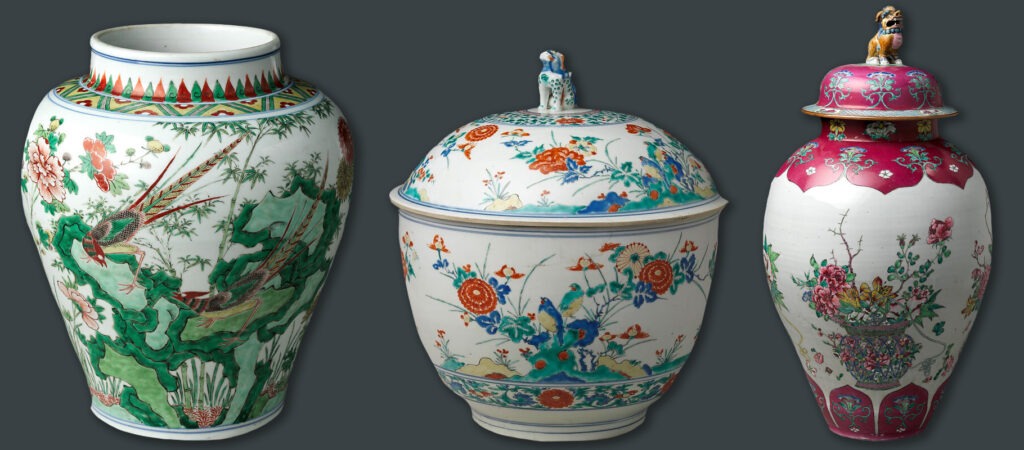
Timely restoration can make the difference between a minor repair and a complete loss. When in doubt, always consult a professional before attempting any intervention.
For particularly rare or valuable enamelware—such as miniatures, Fabergé pieces, or historical artifacts—professional conservation is not just a matter of aesthetics but of long-term preservation. Museums and collectors often invest in expert restoration to ensure that the piece remains stable for decades to come. These treatments are carried out with specialized tools and materials that replicate the original techniques without altering the authenticity of the object.
Preserving Enamel’s Legacy
Antique enamelware holds both artistic and historical significance, making its preservation essential for future generations. Whether it’s a vibrant cloisonné vase or a delicate portrait miniature, these objects tell stories of craftsmanship and cultural heritage. With the right care, collectors and enthusiasts can ensure that the brilliance of enamel continues to shine for years to come.


